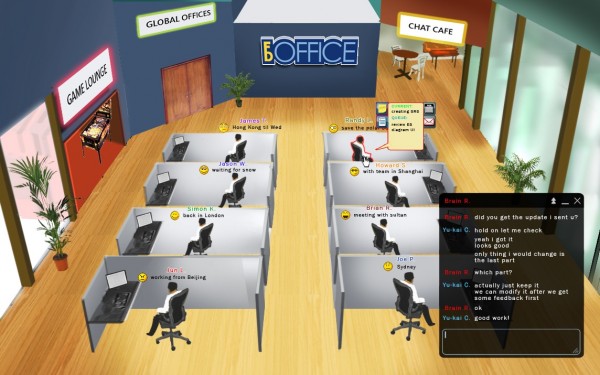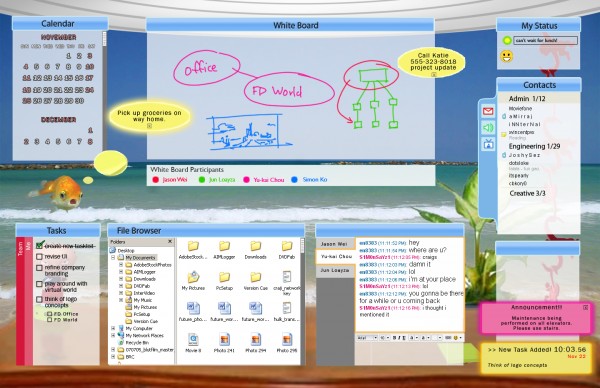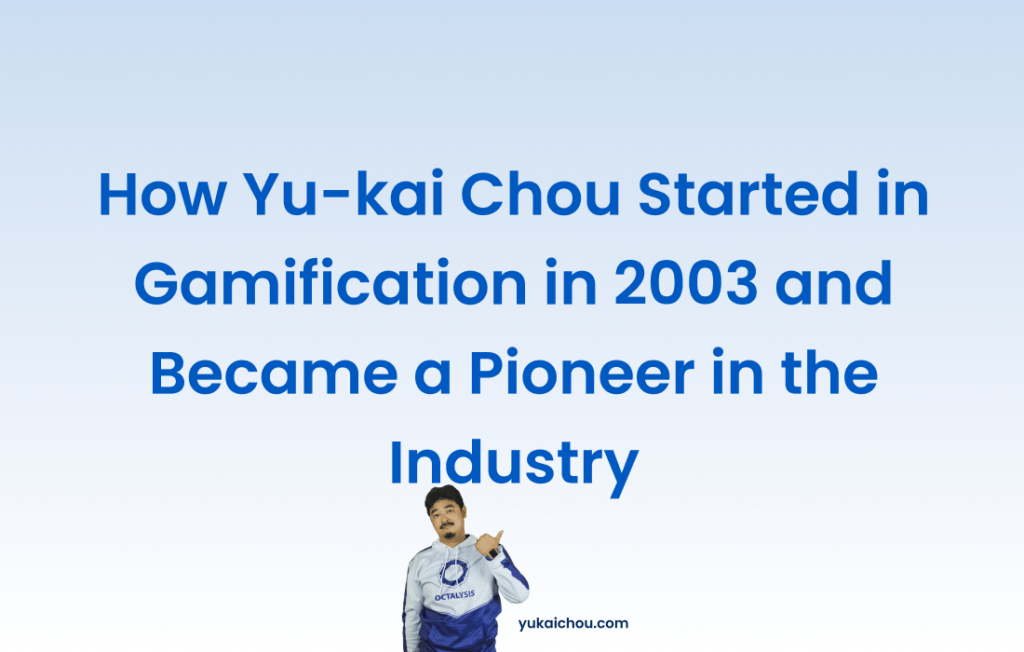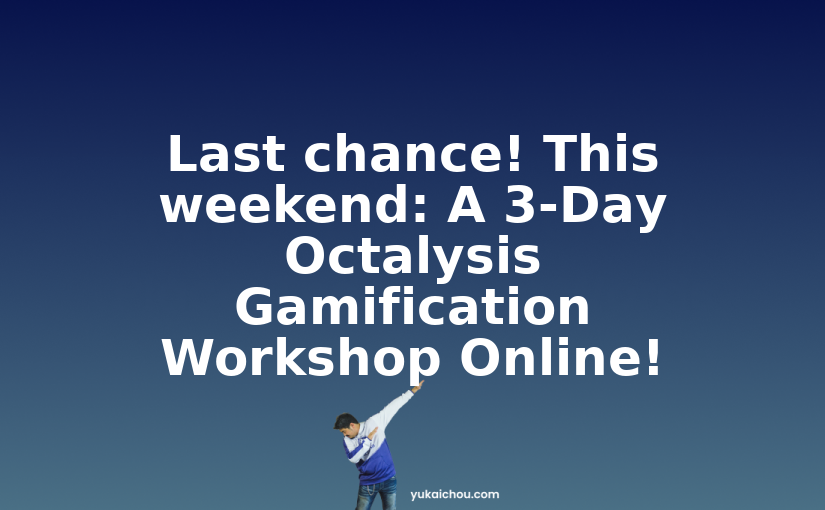New to Gamification? Check out my post What is Gamification & my Gamification Framework: Octalysis
From Gaming to Gamification
Recently, I have been getting more and more people asking me about my experiences as a pioneer in the Gamification Industry.
Gamification (or the widespread adoption of it) seems so new that it feels difficult to make the claim of starting in 2003, when catchphrases like “Cloud,” “Social Media,” or even “Web 2.0” weren’t even popular.
First, to clarify, I didn’t start “playing games” since 2003. I played games throughout my entire life, from my South Africa days to my Taiwan Days, all the way to my Kansas, California, and Vancouver days (yes, long stories…)
I was a hardcore gamer, and whatever I played, I needed to be the best at it. I was almost incapable of playing a game casually. It was either all or nothing. When I play games, I would whip out spreadsheets to figure out the exact combos that would make me win, read about strategy guides while in the restroom, and become a known thought leader in the forums of various games. There was even once when I broke into my college friend Jun Loayza‘s apartment through the window (he was in class) so I could practice on the game that he owned.
Interestingly, my transition to a Gamification Entrepreneur and Designer came from an epiphany I had when I was in school. Back then I played the Blizzard Game Diablo II very heavily, and had more than 5 characters above Level 90 and a couple above level 96. I was pretty hardcore at it. But at one point, my friends started to quit the game and move onto new games. Eventually I quit too and was in this transition period between games.
And then I suddenly felt extremely empty.
I thought, “I spent thousands upon thousands of hours getting more experience, leveling up, accumulating more gold, collecting better gear. And now I have nothing. Is there really no meaning to all the time I have spent in the past few years?”
I then started spending an obsessive amount of time trying to figure out how to “make games more meaningful” as well as “make life more fun.”
I wrote in more detail about the epiphany Diablo 2 gave me in a very old post, but essentially, that is the beginning of my gamification career and the development of my Lifestyle Gamification concept in 2003, initially called the “FD Lifestyle” (because the term Gamification wasn’t around yet). Here’s a speech I made at Google regarding steps to Lifestyle Gamification.
From Gamification to Entrepreneurship
After that, I started a company called Future Delivery. The goal of Future Delivery was to develop solutions that made productive activities fun.
In my first project, I thought about how to turn networking into a game, so I created a professional network called the FD Network, which turns a person’s network into something exciting as though that person was recruiting for a Mission Impossible quest. People had nicknames, they had “abilities” with levels assigned to them, and they get points if they helped out someone in the network. I found an old (and a bit embarrassing) animated video of the FD Network here for your viewing.
That network gathered all types of professionals, including a Nuclear Propulsion Engineers, a Rabbi, Musicians, entrepreneurs, and a lot more. I also turned my Excel Spreadsheet and Access Database into something I called “The Alliance Game” where I would keep track of what all my friends were doing, where they were in life, and see how I can help them to become more successful. I called this Vertical Networking.

I also remember walking into conferences in the early 2000’s with my elevator pitch, “I am a specialist in turning products and productive tasks into games.” Only to get the blank stare: “We don’t play games here…nor do our customers.” How awkward.
Timing is Everything, in and out of Games.
It was about in 2006 when I finally dove into high tech startup products. I recruited a team and we launched FDCareer, a site that turns career development into an RPG game.
Users would choose their “path,” such as “businessman” or “software engineer,” enter their resume, and an algorithm would break them down into 5 stats: Education, Experience, Leadership, Social, and Initiative.
Then, in order to level up, users needed to either get an internship/job in the real world, or complete “quests” on our site. A programmer quest could be like “learn a new programming language and write an AI that beats the computer in tic-tac-toe,” while a business quest could be to solve a business case in real-time.
I remember during that time, I mentioned to my team, “Hey! How about the tagline, ‘Gamify Your Life’?” Sadly for me at the time, my teammates said that it sounded a bit weird and we shouldn’t invent words because it will take too long for the market to accept and adopt it. My team was right – it did take gamification many years of promotion before it became a more commonly recognized word…and it still sounds funny till this day.
FDCareer had some small successes. It was rated on Mashable as one of the Top 10 Social Networks for Gen-Ys, and we had a partnership with Disney Interactive & Media Group, where they could create their own quests on our site and qualify users for a first round interview based on quest performances.
Rule of Surfing: if you start to paddle when the wave is under you, it’s already too late
Our longterm vision was to turn it into an entire Virtual World, where people can network, find jobs, interview, and attend conferences through our platform. At that time, Second Life was really hot, but we saw Second Life as a “Myspace” for virtual worlds, where it is all about self expression with messy designs and dirty images. We wanted to become the LinkedIn for Virtual Worlds, taking advantage of the low barrier to meet new people, but being your authenticated self doing professional activities.


We also played around with ideas of a virtual office, where remote teams can feel like they are “part of a culture,” while communicating easily in a more organized fashion. We were excited about all these concepts.


Unfortunately, that’s when the economy crashed in 2008. Every company was looking to lay off everyone they could, so our platform that makes hiring more efficient through gaming became completely useless. And with no funding in sight, we had to change directions.
My team and I then worked on a few other projects afterwards, including Viralogy, a social media rank, where bloggers would see how influential their blogs are and increase in their “V Score,” and RewardMe, a digital loyalty program that aims to bring Gamification into offline stores and restaurants. RewardMe eventually raised over $1M, was rated as a Top 10 Private Company to Watch by AlwaysOn, and was a Top 3 Finalist for Best Commercial App in the first ever LBS awards – The Locals.
Creating the Gamification Framework: Octalysis
Starting around 2009-2010, Gamification slowly became a buzzword, thanks to Bunch Ball’s efforts. I was excited to see how people have started to accept and even endorse these concepts that I have been pushing all along! I was approached by many companies for consulting/advisory gigs, and invited to speak at various organizations and conferences, including Stanford University, and Google Inc..
But then came a problem: whenever a niche craft becomes a buzzword, everyone starts to claim that they’re gurus, and many agencies would label that buzzword into their latest “expertise” when many of them have never even seriously played a game before (and the ones who do have never applied gaming to business). Everyone stays at the PBL stage (Points, Badges, and Leaderboard), or starts off thinking, “OK…how do I fit game mechanics here?”
And because of that, the industry is getting plagued with people who don’t know how to gamify correctly (just like 3 years ago, there were a ton of “Social Media Gurus” that only knew how to create Facebook Pages and Twitter Profiles). Of course, there are a handful of good Gamifiers out there too – not everyone’s faking it until they make it. But many of “experts” out there would just have clients put on some PBLs, just to hear from the client, “Well, it didn’t work too well. I guess gamification doesn’t work.”
What people fail to remember, is that ALL games have Game Elements in them. But most games SUCK, and only a few WELL-DESIGNED games achieve the status of Winning & Addicting. It is for this reason I gathered all my years of gamification experience, crystalized what worked, what didn’t work (and trust me, there were a lot more that didn’t work), and created the Gamification Framework called Octalysis to help the world gamify things better. I also started a 90 Episode Video Series called The Beginner’s Guide to Gamification to educate those who prefer being entertained over reading text.
The underlying idea of Octalysis is that, instead of starting with the game mechanics (or elements…I like to stay out of semantics wars between game designers and gamifiers), and figure out “where to put the leaderboard,” and “where to add a narrative,” a good Gamification Designer should always start off with the Core Drives and focus on how they want to make the users “feel.” Core Drives include “Epic Meaning & Calling,” “Expression of Creativity & Feedback”, and “Unpredictability & Curiosity.” In total there are 8 of these core drives, creating an Octagon shape with “Left Brain” Core Drives on the left, “Right Brain” Core Drives on the right, “White Hat Gamification” Core Drives on top, and of course, “Black Hat” on the bottom.
Imagine a game designer who thinks, “Okay…we want a game with swords. Where do the swords go. Okay…we need monsters too. Where should they go? Oh of course! We need Cows! And friends who can fertilize them!” The game designer could create a game with all the right “game elements” but still make it extremely boring/stupid. A good game designer should start off with how they want the gamer to FEEL. Do they want the gamer to feel inspired? Accomplished? Even Scared? Once that is determined, THEN the game designer can implement the right elements such as swords and cows into the game to accomplish that goal. The game elements are a means to an end and not an end in itself.
Similarly, in gamification, once the designer has determined which Core Drives they want to appeal to, THEN they derive out the right game elements/mechanics to fulfill that drive. Of course, after that, you figure out the 4 Experience Phases of a Player’s Journey, factor in Bartles 4 Player Types, and created a nice 4×4 Matrix of Octagons to go into hardcore mode if you like challenges.
Since then, my Octalysis model has been translated into 6 different languages, and I was recently rated Number 8 among the Top 40 Gamification Gurus.
The Quest to Give Gamification the Chance it Deserves
The reason why I’m in gamification is not because I think it’s “interesting” or “cool,” nor because I think this is a money-making buzzword in a booming industry. I’m in gamification because I’ve lived it and breathed it throughout my entire productive life. It is my passion and the dream I am living.
While I am very happy and excited that Gamification is being recognized throughout the world now, it also brings me genuine sorrow to see the industry being plundered by opportunists who will smack on PBLs today and move on to the next big buzz word tomorrow. I believe Gamification has the potential power to create a world where everyone has fun in their work; every company performs better because people actually WANT to do the work and customers actually ENJOY the products; and society becomes a lot more productive as a whole.
That vision is possible with Gamification, but we only have one shot at it. In the next 2-3 years, the industry will decide if Gamification is useful enough to stay around in everything people do, or simply become a gimmicky afterthought. If all the industry is hearing about is PBLs and Pointification (btw, those do help actually), we might lose our chance forever. And that is why I am dedicating myself to give Gamification the chance it deserves in the industry.
We should build the future of Gamification, not screw Gamification.








